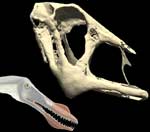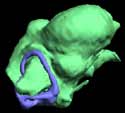Literature
Bennett, S. C. 2001. The osteology and functional morphology of the Late Cretaceous pterosaur
Pteranodon. Part I. General description of osteology. Palaeontogr. Abt. A 260, 1–112.
Blanks, R. H. I., Curthoys, I. S. & Markham, C. H. 1972. Planar relationships of semicircular canals in the cat. Am. J. Physiol. 223, 55–62.
Brochu, C. A. 2001. Progress and future directions in archosaur phylogenetics. J. Paleontol. 75, 1185–1201.
Butler, A. B. & Hodos, W. 1996. Comparative Vertebrate Neuroanatomy: Evolution and Adaptation 514 (Wiley-Liss, New York).
Chatterjee, S. & Templin, R. J. The terrestrial and aerial locomotion of pterosaurs. Geol. Soc. Am. Spec. Publ. (in the press).
de Beer, G. R. 1947. How animals hold their heads. Proc. Linn. Soc. Lond. 159, 125–139.
Duijm, M. 1951. On the head posture of some birds and its relation to some anatomical features. Proc. Koninkl. Nederl. Akad. Wetensch. C 54, 202–211, 260–271.
Edinger, T. 1927. Das Gehirn der Pterosaurier. Z. Anat. Entwicklungsgesch. 82, 105–112.
Edinger, T. 1941. The brain of
Pterodactylus. Am. J. Sci. 239, 665–682.
Erichsen, J. T., Hodos, W., Evinger, C., Bessette, B. B. & Phillips, S. J. 1989. Head orientation in pigeons: postural, locomotor and visual determinants. Brain Behav. Evol. 33, 268–278.
Hopson, J. A. 1979. In Biology of the Reptilia Vol. 9 Neurology A (eds Gans, C., Northcutt, R. G. & Ulinki, P.) 39–146 (Academic, New York).
Hurlburt, G. R. 1996. Relative Brain Size in Recent and Fossil Amniotes: Determination and Interpretation, 250, PhD thesis, Univ. Toronto.
Jerison, H. J. 1973. Evolution of the Brain and Intelligence 482 (Academic, New York).
Jones, G. M. & Spells, K. E. 1963. A theoretical and comparative study of the functional dependence of the semicircular canal upon its physical dimensions. Proc. R. Soc. Lond. B 157, 403–419.
Kellner, A. W. A. 1996. Description of the braincase of two Early Cretaceous pterosaurs (Pterodactyloidea) from Brazil. Am. Mus. Novit. 3175, 1–34.
Kellner, A. W. A. & Tomida, Y. 2000. Description of a new species of Anhangueridae (Pterodactyloidea) with comments on the pterosaur fauna from the Santana Formation (Aptian-Albian), northeastern Brazil. Nat. Sci. Mus. Monogr. 17, 1–135.
Larsson, H. C. E., Sereno, P. C. & Wilson, J. A. 2000. Forebrain enlargement among nonavian theropod dinosaurs. J. Vert. Paleontol. 20, 615–618.
Lebedkin, S. 1924. Über die Lage des Canalis semicircularis lateralis bei Säugern. Anat. Anz. 58, 447–460.
Newton, E. T. 1888. On the skull, brain, and auditory organ of a new species of pterosaurian (
Scaphognathus purdoni), from the Upper Lias near Whitby Yorkshire. Phil. Trans. R. Soc. Lond. B 179, 503–537.
Proctor, N. S. & Lynch, P. J. 1993. Manual of Ornithology 340 (Yale Univ. Press, New Haven).
Romer, A. S. 1956. Osteology of the Reptiles 772 (Univ. Chicago Press, Chicago).
Spoor, F. & Zonneveld, F. 1998. Comparative review of the human bony labyrinth. Yrbk. Phys. Anthropol. 41, 211–251.
Spoor, F., Bajpal, S., Hussain, S. T., Kumar, K. & Thewissen, J. G. M. 2002. Vestibular evidence for the evolution of aquatic behavior in early cetaceans. Nature 417, 163–166.
Tischlinger, H. & Frey, E. 2002. Ein
Rhamphorhynchus (Pterosauria, Reptilia) mit ungewöhnlicher Flughauterhaltung aus dem Solnhofener Plattenkalk. Archaeopteryx 20, 1–20.
Turkewitsch, B. G. 1934. Zur Anatomie des Gehörorgans der Vögel (Canales semicirculares). Z. Anat. Entwicklungsgesch. 103, 551–608.
Unwin, D. M., Lü, J. & Bakhurina, N. N. 2000. On the systematic and stratigraphic significance of pterosaurs from the Lower Cretaceous Yixian Formation (Jehol Group) of Liaoning, China. Mitt. Mus. Naturk. Berlin Geowiss. Reihe 3, 181–206.
Wellnhofer, P. 1975. Die Rhamphorhynchoidea (Pterosauria) der Oberjura-Plattenkalke Süddeutschlands. Teil I. Allgemeine Skelettmorphologie. Palaeontogr. Abt. A 148, 1–33.
Wellnhofer, P. 1991. The Illustrated Encyclopedia of Pterosaurs 192 (Crescent, New York).
Wharton, D. S. 2002. The Evolution of the Avian Brain. 343, PhD thesis, Univ. Bristol.
Winship, I. R. & Wylie, D. R. W. 2003. Zonal organization of the vestibulocerebellum in pigeons (
Columba livia): I. Climbing fiber input to the flocculus. J. Comp. Neurol. 456, 127–139.




 ,
, 









